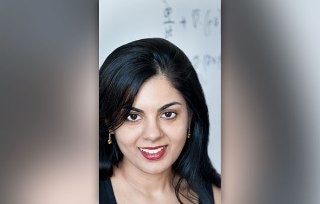Jul 21 2016
RIT professor Sukanya Chakrabarti will talk about dark matter—one of the most compelling topics in astronomy—at the Chabot Space and Science Center in Oakland, Calif., next month.
 Sukanya Chakrabarti (Credit: Rochester Institute of Technology)
Sukanya Chakrabarti (Credit: Rochester Institute of Technology)
Chakrabarti, an assistant professor in RIT’s School of Physics and Astronomy, will present “The Mystery of Dark Matter” at 8 p.m. on Aug. 5, as part of the center’s popular First Friday lecture series. Her talk will be open to the public.
RIT has 4,000 alumni in California and many in the San Francisco Bay area, and Chakrabarti looks forward to connecting with alumni and friends of RIT in the audience. This will be her second public talk in California this year, following an April engagement at the San Jose Astronomical Association. Chakrabarti’s TEDx Talk on dark matter last year has led to opportunities like these to share her research with general audiences.
“My goal is to inspire people to think about the mysteries of the universe, and also hopefully to think more critically and question things,” Chakrabarti said. “What RIT has done particularly well is to expand its research areas in specialty areas like astronomy, and it’s a good opportunity to talk about the work we’re doing with students.”
Her research focuses on dark matter, the invisible particles that make up 85 percent of the universe, and developing a method for understanding how it is distributed in galaxies. Chakrabarti’s research adapts techniques from seismology to explore interiors of galaxies dominated by dark matter. Her work, funded by the National Science Foundation and the National Radio Astronomy Observatory, has provided RIT graduate student Andy Lipnicky more than 200 hours of observing experience at the radio telescope site in Green Bank, West Virginia, and on the Swope Telescope in Chile that is part of Las Campanas Observatory.
“The opportunities that I’ve had through RIT and my advisor have really allowed me to do what I’ve always dreamed of doing, which is getting to use world class telescopes to do astronomy,” said Lipnicky, a Ph.D. candidate in the astrophysical sciences and technology program. “Not many people get the opportunity to observe all over the world and I’m really thankful for the experience."
Lipnicky and Chakrabarti—who are also members of RIT’s Center for Computational Relativity and Gravitation—are now preparing to analyze traces of atomic hydrogen in gravitationally lensed spiral galaxies to infer the dark matter distribution in these galaxies.
“The idea is similar to dropping pebbles in a pond—where the pond is the atomic hydrogen in the galaxy. From analyzing the ripples in the pond, we could figure out how massive the pebble was,” Chakrabarti said. “Similarly, by analyzing the ripples in the galactic disk, we can constrain how the dark matter is distributed in galaxies. The particular galaxies we are studying are spiral lenses—so we can get two independent constraints on dark matter for the first time—from gravitational lensing, and from my method of analyzing atomic hydrogen maps.”